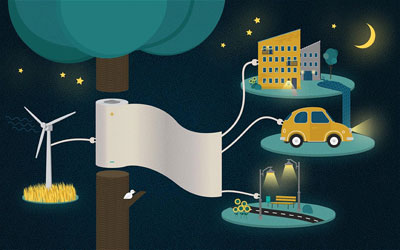Sections
Energy is basically considered as a property of an object as its ability to do work. A precise definition can’t be stated as the definition varies the types of energy. It is believed that the term energy is derived from the Greek word ‘energeia’ meaning activity or operation appeared in the work of Aristotle in BC400. The SI unit of energy is Joules. Energy can be classified as
The list may go on as per the situation and what type of energy being used there. Below figure gives a general classification and how it produces the energy.

The above classification gives the different forms of energy. For everything to happen it require a source and for energy the sources are broadly classified into two namely renewable and non-renewable source of energy.
Renewable source of energy comes from the sources which are replenished in the human time scale like sunlight, tide, wind, waves, rain and geothermal heat. Solar energy is the energy harnessed from the sunlight using any of the passive or active technologies. The energy from the tides is a type of hydropower extracted from the tide to some useful form. Wind energy is the energy extracted from the wind using windmills. Wave energy convertor is used to exploit the energy from the ocean to some useful form. In 2008, the researchers from the France were successful in developing a system that harnesses the mechanical energy of the falling rain drops to electrical energy. The geothermal energy is the thermal energy stored in the center of the Earth and is basically created due to the temperature core of the planet and its surface.
Non-renewable energy is the sources of energy which requires long time to get replenished and some of them are fossil fuels, nuclear fuels etc. They are called non-renewable because they are the result of long process which takes many centuries to complete. Due to the vast usage of these materials for the power generation and the long time period for their replenishment has made the human to shift their focus to renewable source.
The energy produced from whatever source in whatever form requires being stored for future use. The main purpose of this accumulator is to convert the difficult form of energy to convenient or economical form of stored energy. These accumulators can be for short or long term storage purpose. The generally used technologies are:-
This article is also saying about a type of storage device made up of paper. It is called as power paper. This power paper has the same storage capacity that of a supercapacitor. Supercapacitor can be said as an intermediate of battery and capacitor. It is similar to the ordinary capacitor where it stores energy by the principle of electrostatic here it does the same. The main difference it has from the capacitor is its plates are larger and the distance between the two plates is small. The similarity between the batteries is the use of an electrolyte instead of a dielectric material as in capacitor. They were first synthesized in the year 1950.
Using paper is not new in the field of electronics. Paper electronics is one such application. In e-paper a display technology which displays reflect light like paper making it easy for the reading purpose. In another type paper electronics using conducting ink or tape the circuit are constructed.
Similar to that a new class of material has been developed called power paper to store energy. It is made of nanocellulose. We know paper is made from cellulose but in this power paper it is made up of cellulose whose dimension is in nanoscale. When a material size is reduced to the nanoscale its properties varies drastically. They can exist as either CNF or NCC. Using nanocellulose paper a wide research is going on. In one such research the scientists demonstrated the strength and toughness of the paper. As the size of the fibers reduce the toughness and strength increases. This is due to the increase in hydrogen bonds. They are also flexible making them useful in flexible electronics. This material has a quality of self-healing.

In another interesting research the researchers demonstrated the ability of the nanocellulose paper to store electricity. They showed that a sheet of 15 cm length having thickness in micrometer range can store energy up to 1F and can be recharged many times and that take a fraction of minute. A lot of expectations has been tagged with this product because its connection with renewable source. The main motto of them was to develop MIEC (Mixed ionic Electronic Conductor) systems which are abundant in nature, sustainable and light-weight to. It can be classified as ceramic and conducting polymer. Ceramic materials possess good ionic conductivity but still to achieve the electronic conductivity. The conducting polymer has the high electronic conductivity.
In this work the power paper is synthesized using the following components:
NFC stands for Nanofibrillated Cellulose. Here the cellulose fiber undergoes high pressure treatment to produce 20 nm NFC fibers. It will be in the structure of a 3D scaffold. The solvent used here is water. To that solution containing NFC a conducting polymer is added. The conducting polymer used here is PEDOT:PSS. The full form of PEDOT:PSS is poly(3,4-ethylenedioxythiophene) polystyrene sulfonate. It is a polymer made from sodium polystyrene sulfonate and PEDOT. PEDOT is a conjugated polymer having a positive charge in it while PSS have a negative charge. It is transparent; highly ductile finds wide applications in various fields. It forms a thin layer over the fiber. The cellulose fiber used here is in NFC form. The solvent used here is glycerol and DMSO. They together give the material the required ionic and electronic conductivity. To enhance the conductivity of the polymer DMSO (Dimethylsulfoxide) is used. This solution induces dopants into the polymer impacting the morphology of the polymer. This in turn improves the π-stacking resulting in a high conducting percolation path. The NFC will act as a site for tertiary dopant which will enhance the conductivity. Glycerol is added to improve the plasticity and to provide easier path for the ion conduction. Then the solution is homogenized and cast as a film.

This power paper is a holder of 4 records and they are:
Sections